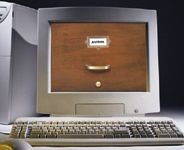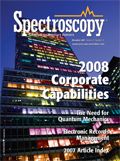Archiving Electronic Records
Paper is easy to archive, but what about archiving electronic records? What do you do with all the electronic records that are generated? In this month's installment, columnist Bob McDowall explores the issue of electronic records management and looks at the recent guidance issued by the OECD for GLP laboratories.

To answer the questions about storage of electronic records, there are two common ways to approach this (apart from deleting them, of course). The first is the BAD (buy another disk) approach and keep the records on line for as long as you need them — or need another disk. The second is to archive them and keep them near line or off-line. Regulations offer little or no help — they just say how long you have to keep them. So what are we going to do?

R.D. McDowall
Some help might be at hand, with the recent publication of another regulatory guidance document in the Good Laboratory Practice (GLP) arena that gives guidance to workers in nonclinical studies and bioanalytical. It comes with the snappy title of Establishment and Control of Archives that Operate in Compliance with the Principles of GLP and was published by the Organization for Economic Cooperation and Development (OECD) in June 2007 (1). This is the organization that is responsible for generating GLP regulations outside of the US and Japan. So let's see what this document can do for us in the spectrometry laboratory.
In the Beginning . . .
. . . there were GLP regulations. Archiving of records and study materials generated during the course of a nonclinical health-safety study is a specific requirement of GLP. The rationale for the archive is that maintenance of the raw data associated with a specific study and the specimens generated from that study are the only means that can be used to reconstruct the study and enable the information presented in the final report to be verified.
The archive is a secure facility or room with an archivist specifically responsible for logging material in and out of the archive. Security and access are major issues within a GLP archive: only authorized personnel have access. This is not the case with GMP regulations.
The key definitions in this document are as follows:
Archive: A designated area or facility (such as a cabinet, room, building, or computerized system) for the secure storage and retention of records and materials.
Archivist: An individual designated by test facility or test site management to be responsible for the management of the archive (that is, for the operations and procedures for archiving).
Electronic archives: Facilities and systems provided to maintain electronic records as required by the Principles of GLP.
Electronic record: All original laboratory records and documentation, including data directly entered into a computer through an instrument interface, which are the results of original observations and activities in a study and which are necessary for the reconstruction and evaluation of the report of that study.
Metadata: Data that describe the attributes of other data. Most commonly, these are data that describe the structure, data elements, interrelationships, and other characteristics of electronic records.
Migration: The transfer of electronic records from one format, media, or computerized system to another.
System owner: The manager, or designee, of the department that is most impacted by, or is the primary user of, the system.
The guidance looks at archiving both in paper and electronic forms; although from many of the definitions here, you can see that the main thrust is toward electronic archiving, and it is this topic that I want to focus on in this column.
Roles and Responsibilities
Ok, so who is involved and what do they do in this archiving process? The guidance document outlines several roles and responsibilities, such as test facility management, study director, quality assurance (QA), information technology (IT), and the archivist. I want to focus on just two for the purposes of this discussion: the archivist and IT. If you work in a GMP-regulated laboratory, you can interpret "archivist" as either QA or the laboratory.

Archivist: The archivist is the gatekeeper for allowing material into and out of the archive. If looking in a GMP laboratory, it's the staff member (or members) responsible for deciding when to move electronic records off-line from the spectrometer. Inevitably, there must be procedures for controlling and recording this process. Therefore, get the structure and the organization of the records right: remember the old saying, "Garbage In, Garbage Out." Therefore, file-naming conventions or a means of indexing these records is important. This can be achieved in a variety of ways and costs: simply by using a directory structure on a dedicated disk, a database, or an export utility if the spectrometer software has this facility, or using a scientific data management system (SDMS).
IT Personnel: IT personnel involved in archiving operations (such as ensuring integrity of electronic records) should be trained adequately and should understand GLP (or GMP) as it relates to their work. They must work closely with the archivist and have either SOPs or written service level agreements (SLAs) to cover this work. Establishment of physical security of the server and the room where it is housed and the logical security of who can access the electronic records are vital, as we will see next.
Archive Facilities
The guidance discusses the facilities at some length. However, let's focus on the facilities for storage of electronic records.
The components that provide storage of unique electronic records should be physically secure.
The computerized archive facility should have processes to prevent unauthorized access and virus protection. This should include both logical and physical security elements.
The security controls necessary to restrict access to electronic records usually will be different from those applied to other record types. Because many electronic storage media can be reused (or overwritten), measures should be implemented to ensure that records cannot be altered or deleted.
For electronic archives, as a minimum, deletion or alteration of electronic records in electronic archives should be avoided. This is too tactfully worded in my view; I would interpret this as, where it says "should," read "must."
In addition, the environmental conditions of the room where the archive servers are housed should be monitored and have an uninterruptible power supply (UPS) to protect the system from power loss. Not mentioned explicitly in the guidance, the computer hardware should be sufficiently resilient to overcome common problems such as disk or processor failures. In addition, disaster recovery including fires and floods should have contingency measures that are documented and work to ensure that electronic records are not lost in the event of failure or disaster.
Archiving Electronic Records
The requirements for archiving of electronic records have additional needs compared with paper, which the guidance presents in five main subject areas and I will discuss in the following sections.
Decision Regarding Electronic Records Retention
There must be a conscious decision to work with electronic records and also retain them. This can require the need for file naming conventions if the current application software cannot do this.
Storage Media
The decision to retain electronic records has major ramifications for any laboratory and will influence the choice of storage media. One key issue is the off-line storage media change. Look at the issue with the current DVD replacement wars: BluRay or HD-DVD — which one will you place your money on? From my perspective, the best way to store records is online to avoid the media problems.
This now brings the next issue: Can we read the data in the same format for the length of the retention period? We might need the original software, or we might need to migrate records to a new file format to ensure readability. Computer technology is developing rapidly, and devices capable of reading storage media in common use today probably will not be available in the future. If records need to be migrated, procedures must be in place to ensure the integrity of data from one format to another. Do not be surprised if data elements are lost during the migration, but this needs to be documented and the impact assessed. This is reflected in the guidance as follows: Electronic media can be discarded when the media itself no longer permits evaluation (due to hardware or software issues) provided the disposal is authorized, documented, and electronic records are migrated and any record losses documented.
Defined Archive Area on a Computerized System
Electronic records can be moved from the production part of a computerized system to a discrete, secure archive area on the same computer system (physically separated, such as file record systems), or explicitly marked as archived (logically separated, such as database record systems). Archived records should be locked so that they cannot be altered or deleted without detection.
Again, in a pragmatic way, the guidance offers the following advice; viewing electronic records without the possibility of alteration or deletion of the archived electronic record or replicating within another computerized system does not constitute retrieval of a record. This offers a major advantage over a paper archive — you must be inside the archive to see the physical paper record. In the electronic world, anyone could have read-only access to the electronic record.
Dedicated Electronic Archive System
Complete electronic records must be entered into the archive system. This includes all the data and metadata, including electronic signatures required for reconstruction of a study, otherwise the migration is useless. When electronic records are being transferred into the archive, the person doing this must ensure that there is agreement between what is documented to be transferred and what actually has been transferred. Ideally, the archivist should be the system owner and have an SLA with IT to manage the system.
Maintenance and Preservation of Electronic Records
This is the difficult bit — we have about 2000 years experience handling paper records but less than 50 years with computerized systems, less if you consider that it was only in the 1980s when computers became widely available to many people. Procedures should be in place to ensure that essential information remains complete and retrievable throughout the specified retention period, and this also includes the mechanisms for backing up the systems.
What might be problematic is the following statement: "If the record medium requires processing in order to render the retained records into a readable format, then the continued availability of appropriate equipment should be ensured." This is the problem because how many vendors provide a future proof method of maintaining electronic records? Standards to help migration are emerging but need to be adopted widely — alternatively, we are back to migration.
If electronic record migration is necessary, the process of migration should be fully documented and validated to ensure complete and accurate migration of the original records before they are lost or destroyed. If it is impossible to migrate the records to new electronic media, it might be necessary to migrate to paper records.
Conclusions
I have summarized the OECD GLP guidance document on archiving in this column; it is an important guidance because for the first time, it attempts to interpret from a regulatory perspective the basic operating principles for an electronic archive. I have not summarized the whole document but just focused on the electronic record portion. For those readers who need more information, I recommend reading the original document.
R.D. McDowall is principal of McDowall Consulting and director of R.D. McDowall Limited, and "Questions of Quality" column editor for LCGC Europe, Spectroscopy's sister magazine. Address correspondence to him at 73 Murray Avenue, Bromley, Kent, BR1 3DJ, UK.
Reference
(1) OECD Series on Principles of Good Laboratory Practice and Compliance Monitoring, Number 15, Establishment and Control of Archives that Operate in Compliance with the Principles of GLP, June 2007.
Best of the Week: AI and IoT for Pollution Monitoring, High Speed Laser MS
April 25th 2025Top articles published this week include a preview of our upcoming content series for National Space Day, a news story about air quality monitoring, and an announcement from Metrohm about their new Midwest office.
LIBS Illuminates the Hidden Health Risks of Indoor Welding and Soldering
April 23rd 2025A new dual-spectroscopy approach reveals real-time pollution threats in indoor workspaces. Chinese researchers have pioneered the use of laser-induced breakdown spectroscopy (LIBS) and aerosol mass spectrometry to uncover and monitor harmful heavy metal and dust emissions from soldering and welding in real-time. These complementary tools offer a fast, accurate means to evaluate air quality threats in industrial and indoor environments—where people spend most of their time.
Smarter Sensors, Cleaner Earth Using AI and IoT for Pollution Monitoring
April 22nd 2025A global research team has detailed how smart sensors, artificial intelligence (AI), machine learning, and Internet of Things (IoT) technologies are transforming the detection and management of environmental pollutants. Their comprehensive review highlights how spectroscopy and sensor networks are now key tools in real-time pollution tracking.
New AI Strategy for Mycotoxin Detection in Cereal Grains
April 21st 2025Researchers from Jiangsu University and Zhejiang University of Water Resources and Electric Power have developed a transfer learning approach that significantly enhances the accuracy and adaptability of NIR spectroscopy models for detecting mycotoxins in cereals.
